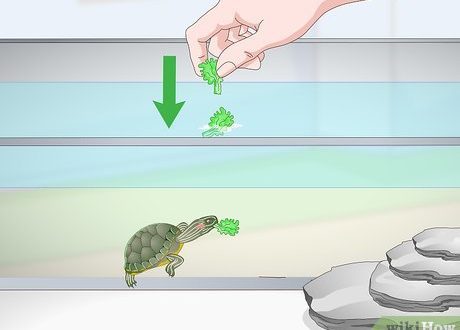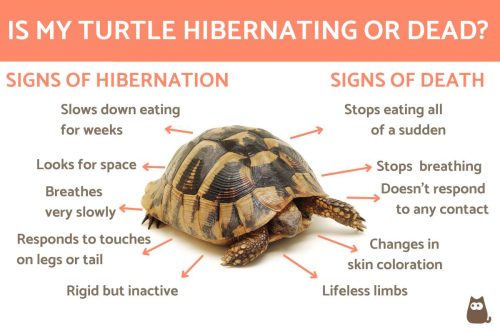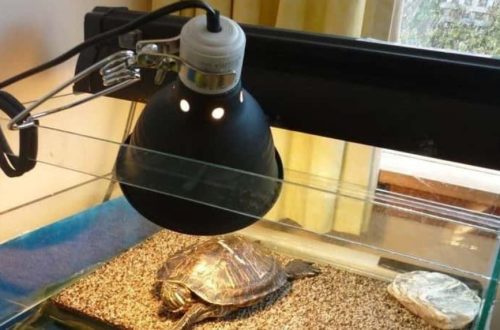Turtle shell: what is it and why is it needed?
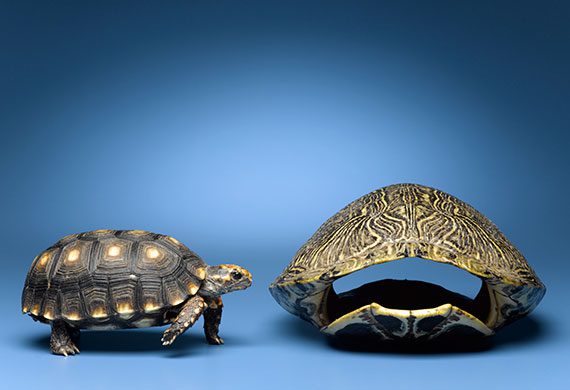
Of all the variety of reptiles, the most amazing animal is the turtle, which always lives in its shell house. It radically changes the structure of the body, skeleton and the development of the muscular apparatus. The presence of a hard stratum corneum on the surface of an animal raises many questions. For example, how is the shell of a turtle arranged and what does it consist of?
Contents
Historical facts: where did the shell come from?
The turtle shell serves as a defense against enemies, in which she can always hide. This is real armor, it reliably protects the animal. The shell consists of two plates (upper and lower), which are supported by fused ribs. This creates a strong structure that can withstand heavy loads.
The formation of the shell proceeded gradually. Given that turtles are ancient animals that have come down to us from the Jurassic period (200 million years ago), it can be assumed that they originally had a different structure. In 2008, Chinese experts found the skeleton of a “toothed turtle with half a shell.” The turtle shell appeared in the course of evolution, and at first only its upper part, the carpax, was developed.
Scientists have found the remains of close relatives of the turtle family, which differed:
- modified, not fused ribs;
- strong claws;
- developed forelimbs.
Non-fused ribs did not provide reliable protection, but allowed the lungs to fill with air. Presumably, during the Permian extinction, when darkness and cooling set in on the planet, the ancestors of the land tortoise hid underground, digging holes. The skeleton and strong muscles helped to dig the ground on the principle of an excavator.
Over time, the ribs began to grow together, and the animal gradually got used to the structure of its body, mastering a new system of breathing and movement. The fused ribs made it possible to unite the upper and lower parts of the “house” into a single whole, and the shell became necessary for the turtle for protection.
This is interesting: It was possible to find the remains of another species of ancestors, and from the bones surrounding the eye sockets, it became obvious that the animals spent most of the time in the dark. This confirms the hypothesis of an underground way of life.
Shell structure
Under the shell of the turtle is the spine, which has the shape of an arc, curved outward. Ribs are attached to it, which are connected to the collarbones in their lower part. The carpax (the so-called back of the tortoise shell shield) and the plastron (lower part) are securely attached to the skeleton and are held in a fixed position by the ribs, so it is impossible to pull the reptile “out of the house”. A turtle cannot live without a shell. It has only three openings for the head, legs and tail that are able to retract inwards.
The structure of the tortoise shell and the peculiarities of the skeleton caused atrophy of most of the abdominal muscles, but the muscular skeleton of the neck and legs is well developed, which allows it to withstand serious loads when moving. The keratinized coating is very durable and can withstand a weight of 200 times more than the animal weighs.
Some individuals have the peculiarity of pulling the carpax to the plastron, creating a dorsal shield of the turtle, under which it feels completely safe, hiding inside. It also performs other functions, protecting the body from excess or lack of heat.
Note: The scutes of the carapace become covered with concentric lines over time. Thanks to them, herpetologists determine the age of the animal and its state of health.
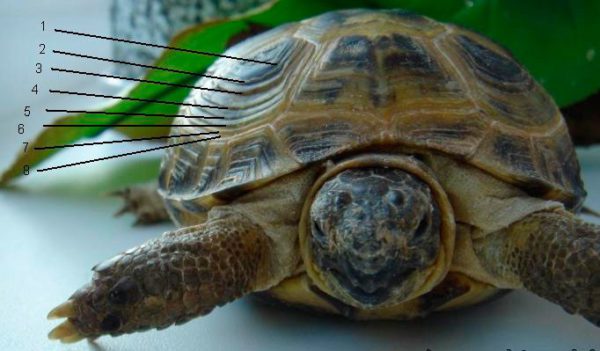
The tortoise shell is made up of dense bony plates. On the carpace of a turtle, the plates are arranged in an orderly manner:
- spinal or middle row;
- lateral, located on the sides of the ridge;
- edge plates.
Outside, the carpax is covered with another layer of keratinized plates, placed randomly. In general, this allows you to form a strong bone shell. In land reptiles, it is domed, in aquatic reptiles it has a more streamlined shape.
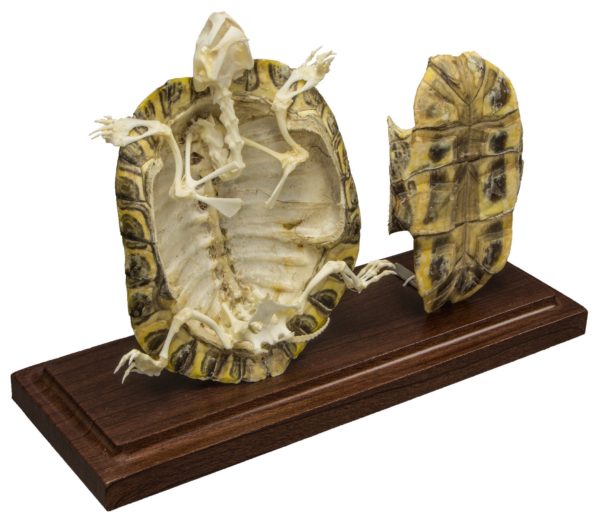
The plastron is formed by 9 bone plates, 4 of which are paired. The ninth is located in the center of the front, the largest plates. The plastron is the anatomical completion of the forelimb girdle and the ribs to which it is attached. In terrestrial forms it is massive and durable, in water forms it is modified to lighter cruciform plates.
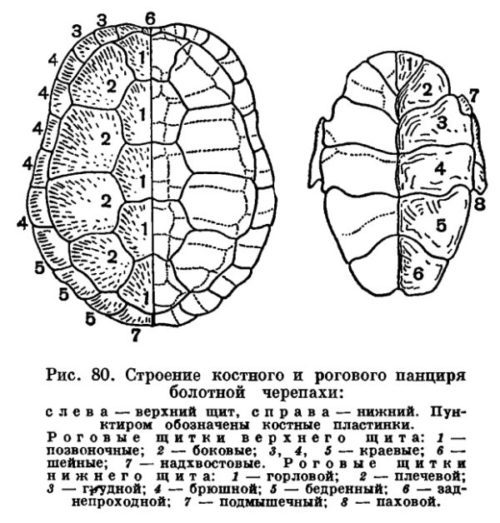
Note: The shell of a turtle is not completely keratinized, it contains nerves and blood vessels. When struck or injured, the animal is injured and in pain.
Strength and coloration of the shell
How durable a turtle’s shell is depends on the specific species, size, and habitat of the animal. But you can’t call it impenetrable. This is used by birds and predators that drop the animal from a height. At the same time, the “protective shell” bursts and the delicacy delicacy is ready to eat.
If the reptile lives in captivity, then it can be dropped, hit, pinched by the door. All this leads to injuries, since the material from which the tortoise shell is made is not armor in the literal sense of the word.
This is interesting: In nature, there is an elastic turtle, which is covered with a soft shell. She is small (body – up to 20 cm) inhabitant of African rocks and savannahs.
In case of danger, it is able to squeeze into the narrowest gap in the rock and the predator cannot pull it out of there.

The coloration and pattern of the horny scutes are varied, they depend on the species and the name of the individual. Thanks to the drawing, it is possible to say with certainty which species a particular animal belongs to. A turtle in a shell of beautiful, multi-colored shields is still the subject of hunting by poachers. Horn formations are used to make spectacle frames, cases, knife handles and other items.
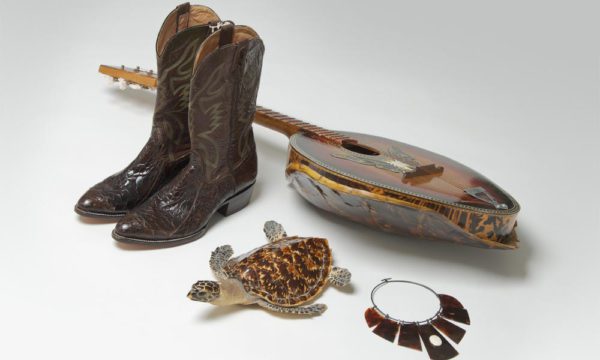
How is the shell formed in baby turtles?
Reptiles do not care about their babies. The hatched cubs at the level of instincts run to the sea or to the shelter on land. During this period, they are very vulnerable, although turtles are born with a shell. But the “protective shell” is not yet sufficiently formed and the “gourmets” (birds, crabs, raccoons) willingly eat the kids.
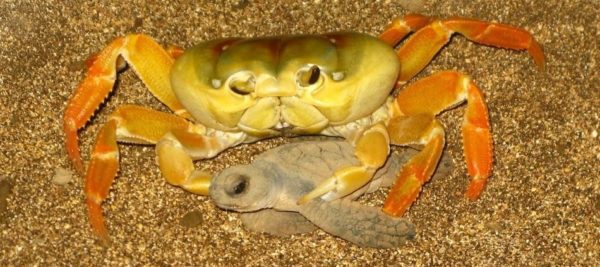
They self-adapt in the environment, and the shell of the turtle is formed simultaneously with its growth, which lasts about 10 years, until the animal becomes an adult. New shields begin to grow at the edges. Between the plates in young individuals there are wide gaps, so the “armor” does not have high strength. Then the oblique plates begin to increase in size and gradually close. This is how a turtle’s shell grows.
In pets, its “pyramidal” growth is sometimes possible, which is a pathology. This is due to the incorrect deposition of keratin – the protein from which the horny plates are formed. There may be spots or discoloration: this is an indication of the development of an infection. Reptiles are characterized by reparative regeneration, during which the injured areas are capable of self-healing.
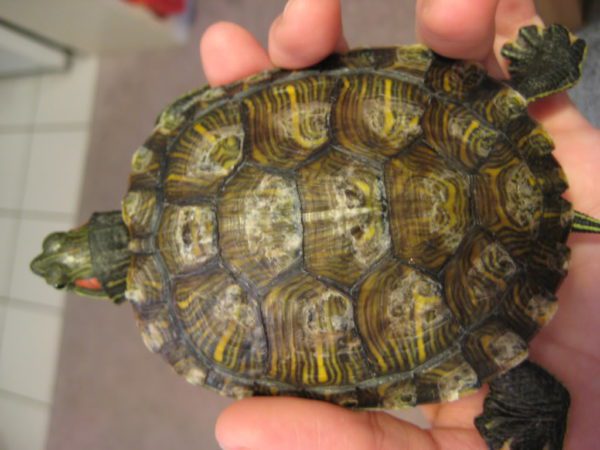
This is interesting: There is phosphorus in the composition of the turtle “dome”. When an animal basks in the sun for a long time, at night it is able to glow, giving away the location of the animal.
Differences in the structure of the shell of land and sea turtles
The structure of the skeleton of marine species is not much different from their land relatives. All turtles have a shell, but its structure is somewhat different for the inhabitants of water and land. In land reptiles, it is very durable. This is a solid armor that has a convex structure.
What is the shell of a turtle living in the aquatic environment? In marine life, it is voluminous and flat. During the evolution of the sea turtle, she developed a teardrop-shaped frame, which is streamlined and allows you to quickly move in the water layers. Since the shell is flat, and the head and flippers of the marine life are large, he is not able to hide them. Speed is the key to the safety of the animal and the ability to get food. The front flippers are larger and more powerful than the rear ones, they help the reptile move faster.
This is interesting: Marine inhabitants are quite large in size. They are “too tough” for many marine predators, as they are not able to swallow a huge reptile.
Among marine individuals, the leatherback turtle stands out with a special structure and therefore it is bred into a separate subspecies. She has no claws on her flippers, and the armored horny plates are replaced by a leathery layer of skin. This subspecies of turtle can live without a shell. But this is the only and unique animal, the likes of which do not exist.
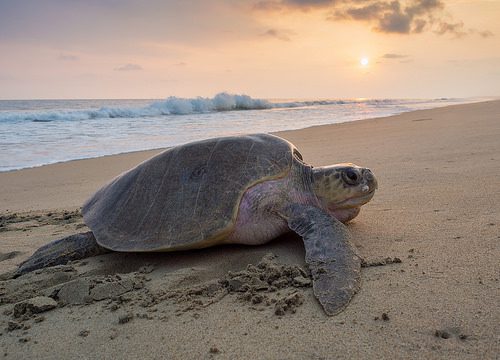
The shell is the “calling card” of the turtle. This unusual reptile walks everywhere with its house. Appearing 200 million years ago, the animal continues its slow journey across the planet. Now we know the answer to the question: why does a turtle need a shell.
The structure and function of the turtle shell
3.4 (67.27%) 11 votes



